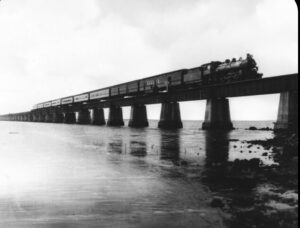The 7 Mile Bridge: A Marvel of Engineering in the Florida Keys

The Majestic 7 Mile Bridge: A Marvel of Engineering in the Florida Keys
Nestled amidst the turquoise waters of the Florida Keys lies a true engineering marvel – the iconic 7 Mile Bridge. Stretching across the azure expanse of the Atlantic Ocean, this architectural masterpiece connects the Middle and Lower Keys, offering breathtaking views and a gateway to paradise. In this blog post, we will delve into the history, significance, and allure of the 7 Mile Bridge, a testament to human ingenuity and a must-visit destination for any traveler.
1. A Brief History:
The original 7 Mile Bridge, also known as the Knights Key-Pigeon Key-Moser Channel-Pacet Channel Bridge, was constructed in the early 1900s as part of Henry Flagler’s ambitious Overseas Railroad project. This railroad connected mainland Florida to Key West, revolutionizing transportation and trade in the region. However, after a devastating hurricane in 1935, the railroad was destroyed, and the bridge was converted into a highway.
2. Engineering Marvel:
The current 7 Mile Bridge, completed in 1982, is a testament to modern engineering prowess. Spanning 6.79 miles (11 kilometers), it is one of the longest segmental bridges in the world. The bridge consists of 546 concrete beams, each weighing 150 tons, supported by 2,800 pilings driven deep into the ocean floor. Its construction required immense precision and innovation, making it an engineering marvel that has stood the test of time.
3. A Scenic Drive:
Driving along the 7 Mile Bridge is an experience like no other. As you traverse the bridge, you are treated to panoramic views of the sparkling ocean, dotted with sailboats and fishing vessels. The bridge’s elevation allows for unobstructed vistas, offering a sense of freedom and tranquility. The journey is particularly enchanting during sunrise or sunset when the sky is painted in hues of orange and pink, creating a picture-perfect backdrop.
4. A Haven for Anglers:
The 7 Mile Bridge is a paradise for fishing enthusiasts. Its strategic location between the Gulf of Mexico and the Atlantic Ocean makes it a prime spot for catching a variety of fish species. Anglers can cast their lines from the bridge or venture to the nearby Pigeon Key, where they can find an abundance of game fish, including tarpon, snapper, and grouper. Whether you are an experienced angler or a novice, the bridge offers an unforgettable fishing experience.
5. A Historical Landmark:
Beyond its engineering marvel, the 7 Mile Bridge holds historical significance. Pigeon Key, located near the bridge, served as a base for the workers who built the original railroad. Today, it is a living museum, preserving the history and heritage of the Overseas Railroad. Visitors can explore the island, visit the restored buildings, and gain insight into the challenges faced by the workers who toiled to connect the Keys.
6. A Gateway to Adventure:
The 7 Mile Bridge serves as a gateway to a plethora of outdoor activities in the Florida Keys. From snorkeling and scuba diving in the vibrant coral reefs to kayaking through mangrove forests, the bridge provides access to a world of adventure. The surrounding waters are teeming with marine life, making it a haven for nature enthusiasts and water sports enthusiasts alike.
However, the 7 Mile Bridge is not just a means of transportation; it is a symbol of human achievement and a gateway to the natural wonders of the Florida Keys. Its awe-inspiring beauty, combined with its historical significance and abundant recreational opportunities, make it a must-visit destination for travelers seeking a unique and unforgettable experience. So, next time you find yourself in the Florida Keys, be sure to take a drive along the majestic 7 Mile Bridge and immerse yourself in its splendor.
It is important to note however, the construction of the 7 Mile Bridge was not without its share of tragedy. During the building of the original railroad bridge in the early 1900s, countless lives were lost due to the harsh working conditions and the unforgiving nature of the ocean. The workers faced extreme heat, treacherous currents, and the constant threat of hurricanes. In fact, the devastating Labor Day Hurricane of 1935 claimed the lives of over 400 workers, forever etching a somber chapter in the bridge’s history. Today, the bridge stands as a memorial to those who sacrificed their lives, reminding us of the human cost behind such remarkable engineering feats. It serves as a poignant reminder of the challenges faced by those who built the Overseas Railroad and the resilience of the human spirit.
